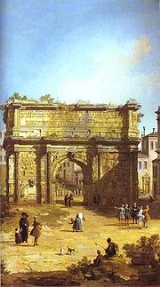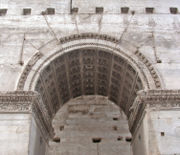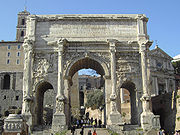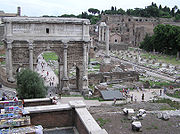
Arch of Septimius Severus
Encyclopedia



Roman Forum
The Roman Forum is a rectangular forum surrounded by the ruins of several important ancient government buildings at the center of the city of Rome. Citizens of the ancient city referred to this space, originally a marketplace, as the Forum Magnum, or simply the Forum...
is a triumphal arch
Triumphal arch
A triumphal arch is a monumental structure in the shape of an archway with one or more arched passageways, often designed to span a road. In its simplest form a triumphal arch consists of two massive piers connected by an arch, crowned with a flat entablature or attic on which a statue might be...
dedicated in AD 203 to commemorate the Parthian victories of Emperor Septimius Severus
Septimius Severus
Septimius Severus , also known as Severus, was Roman Emperor from 193 to 211. Severus was born in Leptis Magna in the province of Africa. As a young man he advanced through the customary succession of offices under the reigns of Marcus Aurelius and Commodus. Severus seized power after the death of...
and his two sons, Caracalla
Caracalla
Caracalla , was Roman emperor from 198 to 217. The eldest son of Septimius Severus, he ruled jointly with his younger brother Geta until he murdered the latter in 211...
and Geta
Publius Septimius Geta
Geta , was a Roman Emperor co-ruling with his father Septimius Severus and his older brother Caracalla from 209 to his death.-Early life:Geta was the younger son of Septimius Severus by his second wife Julia Domna...
, in the two campaigns against the Parthians
Parthian Empire
The Parthian Empire , also known as the Arsacid Empire , was a major Iranian political and cultural power in ancient Persia...
of 194
194
Year 194 was a common year starting on Tuesday of the Julian calendar. At the time, it was known as the Year of the Consulship of Septimius and Septimius...
/195
195
Year 195 was a common year starting on Wednesday of the Julian calendar. At the time, it was known as the Year of the Consulship of Scrapula and Clemens...
and 197
197
Year 197 was a common year starting on Saturday of the Julian calendar. At the time, it was known as the Year of the Consulship of Magius and Rufinus...
-199
199
Year 199 was a common year starting on Monday of the Julian calendar. At the time, it was known as the Year of the Consulship of Annullianus and Fronto...
.
After the death of Septimius Severus, his sons Caracalla and Geta were initially joint emperors. Caracalla had Geta assassinated in 212; Geta's memorials were destroyed and all images or mentions of him were removed from public buildings and monuments. Accordingly Geta's image and inscriptions referring to him were removed from the arch.
Description
The arch was raised on a travertineTravertine
Travertine is a form of limestone deposited by mineral springs, especially hot springs. Travertine often has a fibrous or concentric appearance and exists in white, tan, and cream-colored varieties. It is formed by a process of rapid precipitation of calcium carbonate, often at the mouth of a hot...
base originally approached by steps from the Forum's ancient level. The central archway, spanned by a richly coffer
Coffer
A coffer in architecture, is a sunken panel in the shape of a square, rectangle, or octagon in a ceiling, soffit or vault...
ed semicircular vault
Vault (architecture)
A Vault is an architectural term for an arched form used to provide a space with a ceiling or roof. The parts of a vault exert lateral thrust that require a counter resistance. When vaults are built underground, the ground gives all the resistance required...
, has lateral openings to each side archway, a feature copied in many Early Modern triumphal arches.
The three archways rest on piers
Pier (architecture)
In architecture, a pier is an upright support for a superstructure, such as an arch or bridge. Sections of wall between openings function as piers. The simplest cross section of the pier is square, or rectangular, although other shapes are also common, such as the richly articulated piers of Donato...
, in front of which are detached composite columns
Composite order
The composite order is a mixed order, combining the volutes of the Ionic order capital with the acanthus leaves of the Corinthian order. The composite order volutes are larger, however, and the composite order also has echinus molding with egg-and-dart ornamentation between the volutes...
on pedestal
Pedestal
Pedestal is a term generally applied to the support of a statue or a vase....
s. Winged Victories are carved in relief in the spandrel
Spandrel
A spandrel, less often spandril or splaundrel, is the space between two arches or between an arch and a rectangular enclosure....
s. A staircase in the south pier leads to the top of the monument, on which were statues of the emperor and his two sons in a four-horse chariot (quadriga
Quadriga
A quadriga is a car or chariot drawn by four horses abreast . It was raced in the Ancient Olympic Games and other contests. It is represented in profile as the chariot of gods and heroes on Greek vases and in bas-relief. The quadriga was adopted in ancient Roman chariot racing...
), accompanied by soldiers.

History
The Arch stands close to the foot of the Capitoline HillCapitoline Hill
The Capitoline Hill , between the Forum and the Campus Martius, is one of the seven hills of Rome. It was the citadel of the earliest Romans. By the 16th century, Capitolinus had become Capitolino in Italian, with the alternative Campidoglio stemming from Capitolium. The English word capitol...
. A flight of steps originally led to the central opening, as one still does to the Arch of Trajan at Ancona
Ancona
Ancona is a city and a seaport in the Marche region, in central Italy, with a population of 101,909 . Ancona is the capital of the province of Ancona and of the region....
. By the 4th century erosion had raised the level of the Forum so much that a roadway was put through the Arch for the first time. So much debris and silt eroded from the surrounding hills that the arch was embedded to the base of the columns. The damage wrought by wheeled medieval and early modern traffic can still be seen on the column bases, above the bas-reliefs of the socles.
During the Middle Ages repeated flooding of the low-lying Forum washed in so much additional sediment and debris that when Canaletto painted it in 1742, only the upper half of the Arch showed above ground. The well-preserved condition of the arch owes a good deal to its having been incorporated into the structure of a Christian church. When the church was refounded elsewhere, the arch remained ecclesiastical property and was not demolished for other construction.
Influence
The Arch of ConstantineArch of Constantine
The Arch of Constantine is a triumphal arch in Rome, situated between the Colosseum and the Palatine Hill. It was erected to commemorate Constantine I's victory over Maxentius at the Battle of Milvian Bridge on October 28, 312...
, dedicated in 315
315
Year 315 was a common year starting on Saturday of the Julian calendar. At the time, it was known as the Year of the Consulship of Constantinus and Licinianus...
and located on the other side of the Roman Forum
Roman Forum
The Roman Forum is a rectangular forum surrounded by the ruins of several important ancient government buildings at the center of the city of Rome. Citizens of the ancient city referred to this space, originally a marketplace, as the Forum Magnum, or simply the Forum...
was heavily influenced by the Arch of Septimius Severus.
External links
- Arch of Septimius Severus photo gallery and virtual reality movie.
- Detailed description of the Arch, inscription and base reliefs
- Arcus Septimii Severi, article in Platner's Topographical Dictionary of Ancient Rome
- Arch of Severus

